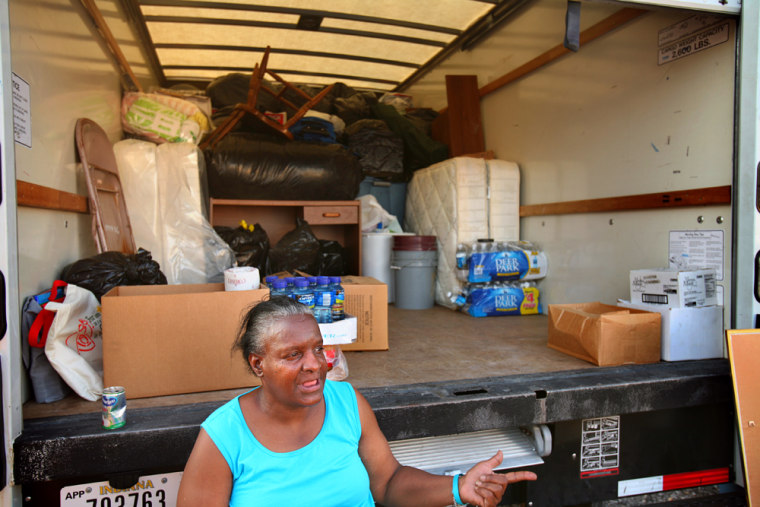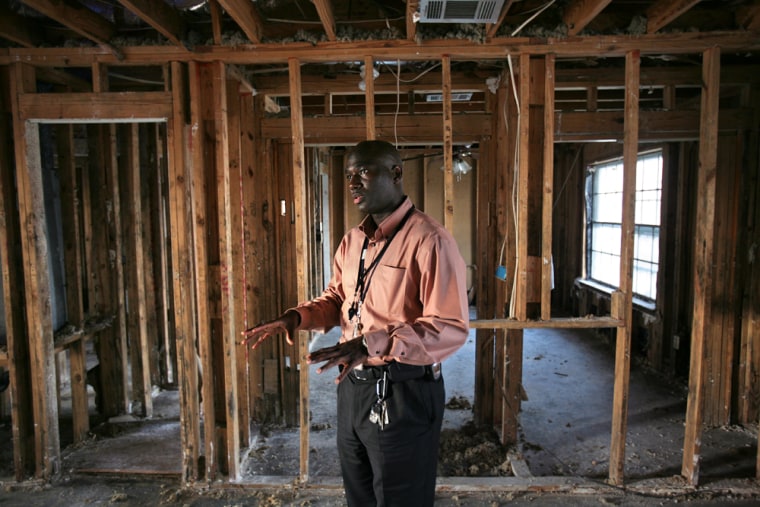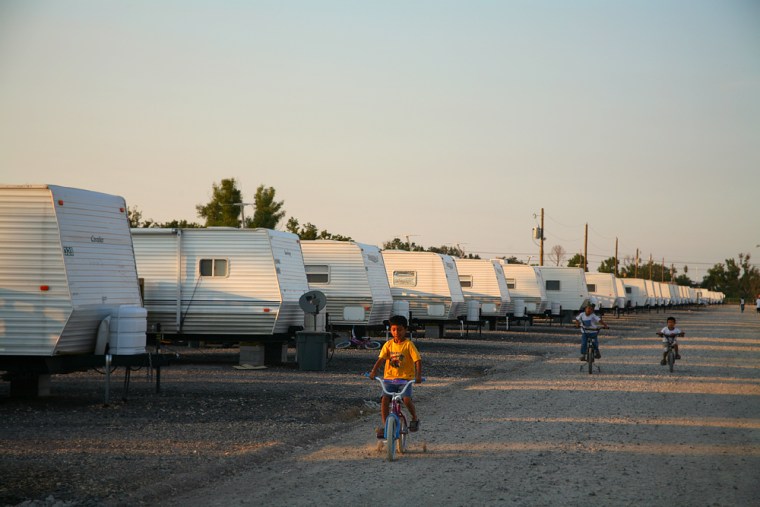BELLE CHASSE, La. — With his Mississippi Delta parish still in tatters from Hurricane Katrina, Benny Rousselle gathers his key people for an exercise to prepare for the fast approaching 2006 hurricane season. Beneath an image of the Gulf Coast projected on the wall, the Plaquemines Parish president is flanked by his emergency adviser, the sheriff, a civil engineer, medics, a school bus coordinator and a representative of local oil and gas interests. It is a scene being repeated in counties across the region.
The group is testy. They are exhausted from nine months of recovery efforts that remain far from finished. Dark humor punctuates the silence as they wait for the Federal Emergency Management Agency to start the disaster response exercise by conference call.
Finally, FEMA announces the scenario: A hypothetical storm dubbed Hurricane Alicia -- a Category 2 storm at this point –- is heading toward southwest Louisiana and expected to make landfall by the following day.
In Belle Chasse, eyes roll and muttering fills the room. Given Alicia’s size and location, the entire parish would already be evacuated and the oil and gas industry shut down. From this vantage point, it’s just one more example of how FEMA always seems to be chronically behind the curve.
“It's always like this. It looks like they forgot us,” Rousselle quips darkly.
In the aftermath of an epic storm that exposed epic problems at FEMA, the exercise frames the question that is on everyone’s lips: Is FEMA prepared to help in a future disaster?
Can FEMA patch the leaks?
Taking its cues from a tidal wave of damning reports by Congress and the agency’s own inspector general that chronicled what went wrong in the response to Katrina, FEMA has rushed to reform its communication, logistics, transportation and procurement systems and replenish its depleted staff. But critics question whether the changes may prove too incremental to make up for gaps in leadership and expertise and an organizational structure that many seasoned emergency professionals say is fundamentally flawed.
FEMA is racing the clock to prove it is up to the task, and not only because hurricane season begins on Thursday. In May, after reviewing the response to Katrina, a bipartisan Senate panel called for elimination of the agency that for 27 years has been tasked with coordinating the federal response to disasters that overwhelm the resources of local and state government.

"We are going to make sure that we don't have another response like we had in Katrina,” new FEMA chief David Paulison promised lawmakers. Paulison, who took over on an interim basis from a bewildered Michael Brown, a political appointee, a few weeks after Katrina hit, was finally confirmed to the post last week by the Senate.
The changes made by Paulison, the former Miami-Dade fire chief, are drawn straight from the pages of the reports. In Katrina, supplies bound for disaster victims — essentials like ice, generators, water and meals — were misdirected, rerouted and delayed by impassable roads. This year, FEMA has a global positioning system — like those widely used by shipping companies and retailers — to track emergency provisions.
In a scramble to distribute emergency money to hundreds of thousands of people displaced by Katrina, FEMA lacked a reliable system to screen out fraudulent applications — resulting in millions of dollars of duplicate payments. This year, FEMA plans to use ChoicePoint, a company specializing in verifying identity, for all emergency aid applications, which it hopes will virtually eliminate the problem.
Monumental blunder, televised
FEMA’s single most-monumental blunder after Katrina was its inability to render prompt assistance when Louisiana officials asked for help evacuating residents stranded in New Orleans and other nearby areas.
While local and state government shared responsibility for the debacle – broadcast live through horrifying images of thousands of increasingly desperate people stuck in New Orleans – it was FEMA’s inept response that drew the most outrage.
It took the agency two days to make its first request for buses, and they arrived in large numbers only four days after Katrina hit the city. The evacuation wasn't complete for another two days.
"These efforts were too little, too late," said a Senate report issued in May. "Tens of thousands of people were forced to wait in unspeakably horrible conditions until as late as Saturday (five days after Katrina struck) to be evacuated."
Part of the problem was a lack of backup communication systems to use when the whole region's landlines and cell phones were knocked out.
FEMA officials said that problem had been addressed by modernizing equipment, including the purchase of some 300 satellite phones that were used to good effect when Hurricane Wilma clobbered Florida in October.
But critics note that the agency has not solved one particularly vexing problem: the lack of an “interoperable” emergency communications system that would allow officials from federal, state and local agencies to easily talk to one another.
Critics also say the agency has to repair weak links between local officials and FEMA, which have badly frayed since 2002 – the year FEMA was absorbed into the vast new Department of Homeland Security. These ties, veteran FEMA officials say, are at the heart of coordinating relief and recovery.
Frayed ties
Under DHS, FEMA lost the responsibility of handling emergency planning grants, money that agency officials had previously been able to direct toward emergency preparations at the local level. But the focus of grants in the new set up shifted toward terrorism preparedness, from projects aimed at more mundane disasters like earthquakes and hurricanes. It also ended one reason for constant give and take between FEMA and local emergency officials.
"FEMA built a strong reputation in the 1990s by having good contacts with the local people. That’s something that has to be done continuously," said Leo Bosner, a longtime FEMA employee and head of Local 4060 of the American Federation of Government Employees. "… When you need it, you can’t just snap your fingers."
Increased staffing should improve the situation. FEMA is hiring now after losing nearly a third of its total permanent staff in the last three to four years, so emergency employees won't be stretched quite so thin.
Moreover, the agency has been making an effort to hire locals to aid in recovery, a move that it hopes will go a long way toward translating FEMA's efforts for residents who feel the outsiders just don't get it.

"I don't mind walking downtown with my FEMA badge," said Wali Armstead, an optimistic FEMA reservist who helps coordinate with the local government, local press and angry residents in his hometown of New Orleans. "After you get chewed out, you get an opportunity to answer questions."
He said many people who are angry with FEMA don't seem to understand the massive scope of Katrina and the other devastating storms of 2005 or just how many people the agency is trying to help at once. He said he tries to offer them assistance as well as perspective.
Harder fix: Morale
But a hiring spree doesn't necessarily address morale at the agency, which has seen an exodus of veteran emergency professionals in recent years, especially if the new hires lack either expertise or the authority to make decisions.
Nor does it diminish the frustration of longtime FEMA employees who have seen the status and capabilities of the agency diminished under DHS, which has the overarching task of protecting the nation. In the system as it is set up, Paulison will still have to go through Homeland Security Secretary Michael Chertoff to get his concerns to the president — rather than having a direct line to the White House as the agency did before it was absorbed by DHS.
Bosner said he experienced first-hand the effects of the additional layer of government in the weeks after Katrina. While working 12-hour night shifts for two months, he said he was frequently interrupted by repeated calls from DHS officials that interfered with his more-urgent work -- preparing daily situation reports.
"We'd get a call in middle of the night, ‘Yesterday you said there were 435 rescues, today there are 432 — we need to know immediately why,’" he recalled. Bosner was not about to wake up people involved in rescues, so he started to lie to his inquisitors. "What I started doing was ‘we tried but couldn’t get a connection,’" he said.
Just open the checkbook
Rousselle and his staff in Plaquemines Parish say one of their biggest gripes about FEMA is that the staff members who are on the front lines in a disaster rarely have the final say on how problems get handled.
"You don't need someone to come to an area and view the problem, sympathize with you and … (then) go back to an office and discuss it for weeks at a time," he said. "We need somebody to come here, say, ‘OK, that's an expenditure we will reimburse,’ and do it."

Though about 60 percent of the parish was wiped out by Katrina, only four people died after refusing to evacuate. A few hundred had to be rescued, but most of the nearly 28,000 residents were successfully evacuated — all using local resources.
Rousselle said local officials were relieved when FEMA arrived a few days later, but added that the feeling rapidly turned into frustration.
"We quickly learned that while they do have the checkbook, the resources they brought to bear were somewhat expensive and disorganized," he said.
Rousselle noted that when FEMA stepped in to provide a group site for trailers for temporary housing, the agency turned to one of the world’s largest engineering and construction companies, CH2M HILL. The company vowed to complete the project by mid-December, but they finished two months late, and over budget due to changed orders, he said.
DHS and FEMA officials respond to such criticism by saying the agency will be much more aggressive during the coming storm season.
New leadership touted
Homeland Security Secretary Chertoff touts the new leadership at FEMA: In addition to bringing Paulison aboard, he hired Coast Guard Adm. Harvey Johnson as a deputy director. Johnson directed the rescue and recovery effort after Katrina, generally considered the most effective piece of the federal response to the monster storm.
Chertoff also has promised that he will pass urgent issues on to the president, and said that joint planning with local governments down to “an excruciating level of detail” will minimize confusion this time around.
In addition to conducting five preparedness exercises in regions throughout the country, FEMA has placed defense coordinating officers in the 10 regional FEMA offices to be the “eyes and ears” for the agency. That, he said, will avert any communications debacles similar to what occurred in New Orleans.
As FEMA head Paulison put it in testimony before Congress: “We're going to lean as far forward as possible. … We are going to make sure that we don't have another response like we had in Katrina.”
Despite such assurances, Rousselle remains skeptical: "All I can say is, I hope they don't fall over," he said.